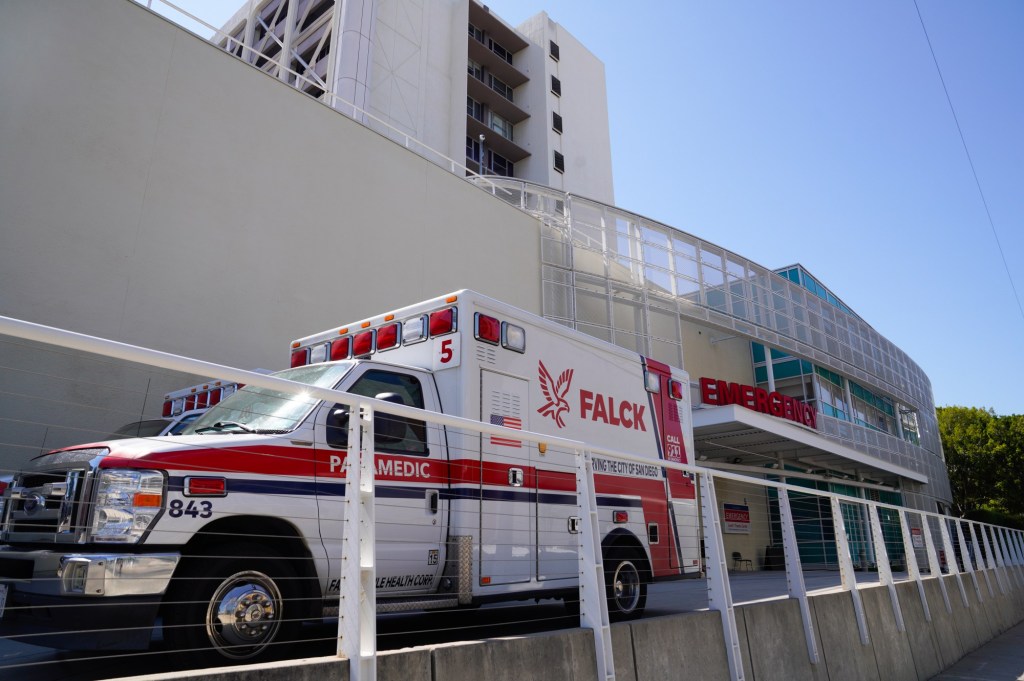San Diego city leaders are floating a proposal to bring the city’s ambulance services in-house, though they seem to be struggling to explain exactly why. Contractor Falck USA has been meeting performance goals and continuing to improve, and the city is even generating greater than expected revenue to help plug its budget hole, so doing so would be like killing the goose that laid the golden eggs (and perhaps awarding an undeserved gift to the city’s public employee unions).
The current ambulance contract with Falck, a Danish company that provides ambulance services throughout several California counties, other Western states and 25 countries across the globe, began in November 2021. To be sure, there were some initial growing pains. During the first few months of its contract, Falck was criticized for not operating enough ambulances and overworking employees. The company was fined $818,500 in 2022 for failing to meet contract terms such as response times.
In fairness, at least some of the performance issues were outside of the company’s control. Hospital drop-off delays have prevented ambulances from becoming available again within a reasonable period of time, leading to delayed response times, not to mention the strain from an increased COVID-19 patient load at the time. Moreover, the nationwide paramedic staffing shortage is not unique to Falck or to San Diego. Nevertheless, Falck stepped up hiring by increasing signing bonuses from $12,000 to $50,000 and raising wages by 17 percent over three years. The city also required Falck to increase capacity by 48 more ambulance hours per day, so it subcontracted with previous provider American Medical Response.
The state government has thrown a wrench into the system as well. As The San Diego Union-Tribune reported in 2023, a new California law made “the reimbursement rates public agencies get from Medicare and Medi-Cal patients nearly triple the rates private ambulance providers get.” This prompted San Diego to alter the contract with Falck and shift to an “alliance model” that allows the city to determine how ambulances are deployed and take over billing and collections activities, which are hardly core government functions. This has proven to be a windfall for the city, allowing it to use $17.3 million in ambulances revenue to help plug substantial budget deficits, currently projected at more than $300 million, but it also exposes the city to increased financial risk.
Councilmember Vivian Moreno has urged the city to go even further and bring all ambulance services in-house, as Los Angeles, San Francisco and Chula Vista have done. But these cities are not exactly models of service quality and good financial stewardship, to put it mildly. According to WalletHub’s recently released 2025 Best- and Worst-Run Cities report, for example, San Francisco ranked dead last, and Los Angeles did not fare much better, ranking 139th out of the 148 of the nation’s largest cities evaluated. (Chula Vista was not included in the report.)
But there is another trait that these cities share: powerful public employee unions that exert significant control over city budgets and operations. This is likely what is going on in San Diego as well.
Privatization tends to yield significant cost savings and service improvements precisely because providers are not subject to the politicization and other shackles that typify monopolistic government provision of services. The competitive pressures of having to periodically bid for contracts lead to greater service levels, accountability and innovation, as potential providers vie to outdo each other to win the contract. Falck beat out AMR, in large part, because of promises, which it has met, to offer more service hours, as well as to use improved models to more efficiently deploy ambulances based on the time and location of typical call volumes. In the past, private ambulance providers have also pioneered innovations such as peak-load staffing and greater use of defibrillation devices and automatic vehicle location technology.
The use of performance-based contracts that include rewards for meeting benchmarks — and penalties for missing them, as San Diego has effectively used — is critical for maximizing service quality and accountability. In the event that you get a bad contractor, you can always replace it with a better one. You don’t have that option if the city is the only one providing services.
In short, there are many benefits to outsourcing services like ambulance transportation to the private sector, which is why San Diego has done it this way for so long. In light of this, and the current arrangement’s success, there really is only one reason city leaders might want to bring services back in-house: as a payoff to public labor unions. Labor costs would certainly increase, particularly given the cost of public pension benefits, and service quality would likely suffer. But the city would add a whole bunch of new union members to its ranks, and then it would be much more difficult to contract out again.
This seems to be a decision borne entirely of political considerations, rather than based on sound economics, which is precisely why such services should be provided by a competitive, free market — not monopolistic government agencies. As such, the in-house ambulance proposal should be DOA.
Summers is a columnist, economist and public policy analyst, and a former editorial writer for the Orange County Register / Southern California News Group.
